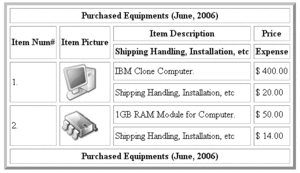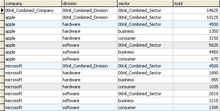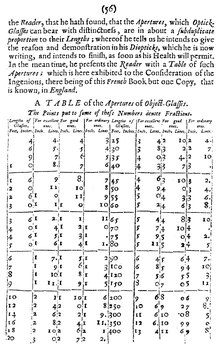Table (information)

A table is an arrangement of information or data, typically in rows and columns, or possibly in a more complex structure. Tables are widely used in communication, research, and data analysis. Tables appear in print media, handwritten notes, computer software, architectural ornamentation, traffic signs, and many other places. The precise conventions and terminology for describing tables vary depending on the context. Further, tables differ significantly in variety, structure, flexibility, notation, representation and use.[1][2][3][4][5] Information or data conveyed in table form is said to be in tabular format (adjective). In books and technical articles, tables are typically presented apart from the main text in numbered and captioned floating blocks.
Basic description
[edit]A table consists of an ordered arrangement of rows and columns. This is a simplified description of the most basic kind of table. Certain considerations follow from this simplified description:
- the term row has several common synonyms (e.g., record, k-tuple, n-tuple, vector);
- the term column has several common synonyms (e.g., field, parameter, property, attribute, stanchion);
- a column is usually identified by a name;
- a column name can consist of a word, phrase or a numerical index;
- the intersection of a row and a column is called a cell.
The elements of a table may be grouped, segmented, or arranged in many different ways, and even nested recursively. Additionally, a table may include metadata, annotations, a header,[6] a footer or other ancillary features.[5]
Simple table
[edit]The following illustrates a simple table with four columns and nine rows. The first row is not counted, because it is only used to display the column names. This is called a "header row".
| First name | Last name | Age | Gender |
|---|---|---|---|
| Jimmy | toewasher | 7 | F |
| Javier | Zapata | 28 | M |
| Lily | McGarrett | 18 | F |
| Olatunkbo | Chijiaku | 22 | M |
| Adrienne | Anthoula | 22 | M |
| Axelia | Athanasios | 22 | M |
| Jon-Kabat | Zinn | 22 | M |
| Thabang | Mosoa | 15 | F |
| Rhian | Ellis | 12 | M |
Multi-dimensional table
[edit]
The concept of dimension is also a part of basic terminology.[7] Any "simple" table can be represented as a "multi-dimensional" table by normalizing the data values into ordered hierarchies. A common example of such a table is a multiplication table.
| × | 1 | 2 | 3 |
|---|---|---|---|
| 1 | 1 | 2 | 3 |
| 2 | 2 | 4 | 6 |
| 3 | 3 | 6 | 9 |
In multi-dimensional tables, each cell in the body of the table (and the value of that cell) relates to the values at the beginnings of the column (i.e. the header), the row, and other structures in more complex tables. This is an injective relation: each combination of the values of the headers row (row 0, for lack of a better term) and the headers column (column 0 for lack of a better term) is related to a unique cell in the table:
- Column 1 and row 1 will only correspond to cell (1,1);
- Column 1 and row 2 will only correspond to cell (2,1) etc.
The first column often presents information dimension description by which the rest of the table is navigated. This column is called "stub column". Tables may contain three or multiple dimensions and can be classified by the number of dimensions. Multi-dimensional tables may have super-rows - rows that describe additional dimensions for the rows that are presented below that row and are usually grouped in a tree-like structure. This structure is typically visually presented with an appropriate number of white spaces in front of each stub's label.[8]
In literature tables often present numerical values, cumulative statistics, categorical values, and at times parallel descriptions in form of text.[9] They can condense large amount of information to a limited space and therefore they are popular in scientific literature in many fields of study.

Generic representation
[edit]As a communication tool, a table allows a form of generalization of information from an unlimited number of different social or scientific contexts. It provides a familiar way to convey information that might otherwise not be obvious or readily understood.
For example, in the following diagram, two alternate representations of the same information are presented side by side. On the left is the NFPA 704 standard "fire diamond" with example values indicated and on the right is a simple table displaying the same values, along with additional information. Both representations convey essentially the same information, but the tabular representation is arguably more comprehensible to someone who is not familiar with the NFPA 704 standard. The tabular representation may not, however, be ideal for every circumstance (for example because of space limitations, or safety reasons).
| Standard Representation | Tabular Representation | ||||||||
|---|---|---|---|---|---|---|---|---|---|
|
Specific uses
[edit]There are several specific situations in which tables are routinely used as a matter of custom or formal convention.
Publishing
[edit]- Cross-reference (Table of contents)
Mathematics
[edit]- Arithmetic (Multiplication table)
- Logic (Truth table)
Natural sciences
[edit]- Chemistry (Periodic table)
- Oceanography (tide table)
Information technology
[edit]Software applications
[edit]Modern software applications give users the ability to generate, format, and edit tables and tabular data for a wide variety of uses, for example:
- word processing applications;
- spreadsheet applications;
- presentation software;
- tables specified in HTML or another markup language
Software development
[edit]Tables have uses in software development for both high-level specification and low-level implementation. Usage in software specification can encompass ad hoc inclusion of simple decision tables in textual documents through to the use of tabular specification methodologies, examples of which include Software Cost Reduction[10] and Statestep.[11] Proponents of tabular techniques, among whom David Parnas is prominent, emphasize their understandability, as well as the quality and cost advantages of a format allowing systematic inspection,[12] while corresponding shortcomings experienced with a graphical notation were cited in motivating the development of at least two tabular approaches.[11][13]
At a programming level, software may be implemented using constructs generally represented or understood as tabular, whether to store data (perhaps to memoize earlier results), for example, in arrays or hash tables, or control tables determining the flow of program execution in response to various events or inputs.
Databases
[edit]Database systems often store data in structures called tables; in which columns are data fields and rows represent data records.
Historical relationship to furniture
[edit]In medieval counting houses, the tables were covered with a piece of checkered cloth, to count money.[14][15]Exchequer is an archaic term for the English institution which accounted for money owed to the monarch. Thus the checkerboard tables of stacks of coins are a concrete realization of this information.[citation needed]
See also
[edit]- Chart
- Diagram
- Abstract data type
- Column (database)
- Information graphics
- Periodic table
- Reference table
- Row (database)
- Table (database)
- Table (HTML)
- Tensor
- Dependent and independent variables
- Zebra striping
References
[edit]- ^ Fink, Arlene (2005). How to Conduct Surveys. Thousand Oaks: Sage Publications. ISBN 1-4129-1423-X.
- ^ McNabb, David (2002). Research Methods in Public Administration and Nonprofit Management. Armonk: M.E. Sharpe. ISBN 0-7656-0957-6.
- ^ Morgan, George (2004). Spss for Introductory Statistics. Hillsdale: Lawrence Erlbaum. ISBN 0-8058-4789-8.
- ^ Robey, David (2000). Sound and Structure in the Divine Comedy. Oxford Oxfordshire: Oxford University Press. ISBN 0-19-818498-0.
- ^ a b Zielinski, Krzysztof (2006). Software Engineering: Evolution and Emerging Technologies. Amsterdam: IOS Press. ISBN 1-58603-559-2.
- ^ see e.g., Page header or Header (computing)
- ^ The concept of "dimension" is often applied to tables in different contexts and with different meanings. For example, what is described as a "Simple Table" in this article is alternatively described as a "two dimensional array". This is distinct from "multi-dimensional table" as presented in this article.
- ^ Milosevic N, Gregson C, Hernandez R, Nenadic G (June 2016). "Disentangling the Structure of Tables in Scientific Literature" (PDF). Proceedings of 21st International Conference on Applications of Natural Language to Information Systems (NLDB 2016). Lecture Notes in Computer Science. 9612: 162–174. doi:10.1007/978-3-319-41754-7_14. ISBN 978-3-319-41753-0. S2CID 19538141.
- ^ Milosevic N, Gregson C, Hernandez R, Nenadic G (February 2019). "A framework for information extraction from tables in biomedical literature". International Journal on Document Analysis and Recognition. 22 (1): 55–78. arXiv:1902.10031. doi:10.1007/s10032-019-00317-0. S2CID 62880746.
- ^ Heitmeyer, Constance L. (2002). "Software Cost Reduction". Washington D.C.: Naval Research Laboratory. Archived from the original on March 12, 2012.
- ^ a b Breen, Michael (2005). "Experience of using a lightweight formal specification method for a commercial embedded system product line" (PDF). Requirements Engineering Journal. 10 (2): 161–172. doi:10.1007/s00766-004-0209-1. S2CID 16928695.
- ^ Janicki, Ryszard; Parnas, David Lorge; Zucker, Jeffery (1997). "Tabular representations in relational documents". In Brink, C.; Kahl, W.; Schmidt, G. (eds.). Relational Methods in Computer Science. Springer Verlag. ISBN 3-211-82971-7.
- ^ Leveson, Nancy G.; Heimdahl, Mats P. E.; Reese, Jon Damon (1999). "Designing Specification Languages for Process-Control Systems: Lessons Learned and Steps to the Future". Seventh ACM SIGSOFT Symposium on the Foundations on Software Engineering (PDF). Lecture Notes in Computer Science. Vol. 1687. pp. 127–146. doi:10.1007/3-540-48166-4_9. hdl:11299/217294. ISBN 978-3-540-66538-0.
- ^ Baxter, W. T. (1989). "Early Accounting: The Tally and Checkerboard". The Accounting Historians Journal. 16 (2): 43–83. doi:10.2308/0148-4184.16.2.43. ISSN 0148-4184. JSTOR 40697984.
- ^ "The Exchequer: a chequered history? - History of government". history.blog.gov.uk. 14 August 2013. Retrieved 2023-04-13.
External links
[edit] Media related to Tables (information) at Wikimedia Commons
Media related to Tables (information) at Wikimedia Commons

